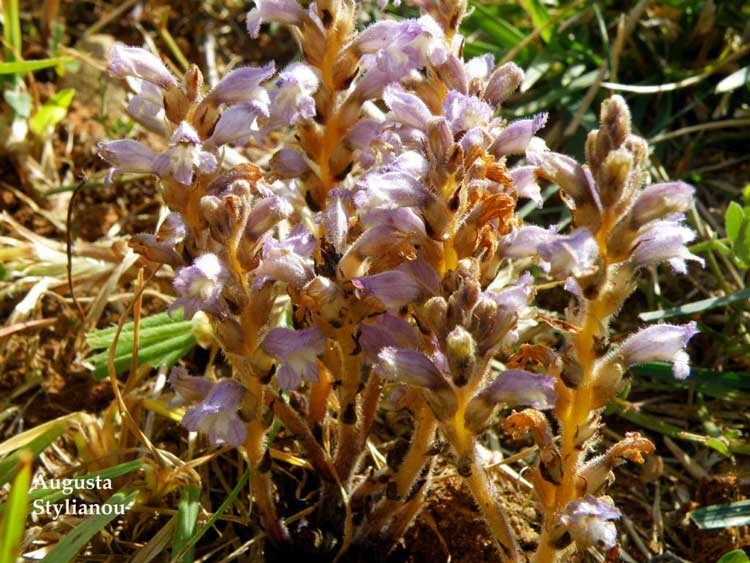
Orobanche ramosa , Amathos River, Germasogeia (Yermasoyia), Cyprus, Photo: Augusta Stylianou Artist
Classification System: APG IV
Superregnum: Eukaryota
Regnum: Plantae
Cladus: Angiosperms
Cladus: Eudicots
Cladus: Core eudicots
Cladus: Asterids
Cladus: Lamiids
Ordo: Lamiales
Familia: Orobanchaceae
Tribus: Orobancheae
Genus: Orobanche
Species: Orobanche ramosa
Subspecies: O. r. subsp. mutelii
Name
Orobanche ramosa L.
References
Linnaeus, C. 1753. Species Plantarum. Tomus II: 633. Reference page.
USDA, ARS, Germplasm Resources Information Network. Orobanche ramosa in the Germplasm Resources Information Network (GRIN), U.S. Department of Agriculture Agricultural Research Service.
Vernacular names
العربية: هالوك متفرع
беларуская: Заразіха галінастая
català: frare blau
čeština: záraza větevnatá
Cymraeg: Gorfanc Canghennog
Deutsch: Ästige Sommerwurz
English: hemp broomrape, branched broomrape
Esperanto: Phelipanche ramosa
suomi: Tupakannäive
français: Orobanche rameuse
עברית: עלקת ענפה
hornjoserbsce: Hałžkata hubinka
հայերեն: ճրագախոտ ճյուղավոր
Nederlands: Hennepvreter
polski: Zaraza gałęzista
slovenčina: zárazovec konáristý
українська: Вовчок гіллястий, Гіллястий вовчок
Orobanche ramosa is a species of broomrape known by the common names hemp broomrape[1][2] and branched broomrape. It is native to Eurasia and North Africa, but it is known in many other places as an introduced species and sometimes a noxious weed.[3]
It is a pest in agricultural fields, infesting crops including tobacco, potato,[4] and tomato.[5]
The plant produces many slender, erect stems from a thick root. The yellowish stems grow 10 to 60 centimeters tall and are coated in glandular hairs. The broomrape is parasitic on other plants, draining nutrients from their roots, and it lacks leaves and chlorophyll. The inflorescence bears several flowers, each in a yellowish calyx of sepals and with a tubular white and blue to purple corolla.
References
BSBI List 2007 (xls). Botanical Society of Britain and Ireland. Archived from the original (xls) on 2015-06-26. Retrieved 2014-10-17.
USDA, NRCS (n.d.). "Orobanche ramosa". The PLANTS Database (plants.usda.gov). Greensboro, North Carolina: National Plant Data Team. Retrieved 30 January 2016.
Joel, D. M. (2009). "The new nomenclature of Orobanche and Phelipanche". Weed Research. 49: 6–7. doi:10.1111/j.1365-3180.2009.00748.x.
Haidar, M. A.; et al. (2005). "Selective control of Orobanche ramosa in potato with rimsulfuron and sub-lethal doses of glyphosate". Crop Protection. 24 (8): 743–47. doi:10.1016/j.cropro.2005.01.005.
Mauromicale, G.; et al. (2008). "Effect of branched broomrape (Orobanche ramosa) infection on the growth and photosynthesis of tomato". Weed Science. 56 (4): 574–81. doi:10.1614/ws-07-147.1. S2CID 85691913.
Further reading
Cimmino, Alessio; et al. (Oct 29, 2014). "Effect of Fungal and Plant Metabolites on Broomrapes (Orobanche and Phelipanche spp.) Seed Germination and Radicle Growth". Journal of Agricultural and Food Chemistry. 62 (43): 10485–10492. doi:10.1021/jf504609w. PMID 25272312. Retrieved 29 April 2015.
Retrieved from "http://en.wikipedia.org/"
All text is available under the terms of the GNU Free Documentation License

